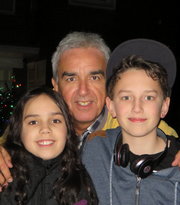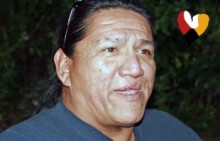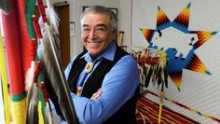Judy Atkinson is an expert in understanding inter-generational healing and recovery from trauma in Aboriginal and Torres Strait Islander peoples. At the core of this moving talk, she describes her approach to healing. It’s about listening. In order to heal, the stories behind the trauma must be heard. TEDx Talks. [16’14”]
Owning One’s Past and Committing to One’s Future
Michael Chandler speaks about the eight variables that affect owning one’s past and committing to one’s future, especially as they relate to Aboriginal communities and the preservation of culture. TRU, Open Learning. [2’58”]
Don Coyhis: 2009 Purpose Prize Winner
Don Coyhis developed the grassroots Wellbriety Movement that provides culturally based healing for Indigenous people. The mission of The Wellbriety Movement is to disseminate culturally based principles, values, and teachings to support healthy community development and servant leadership, and to support healing from alcohol, substance abuse, co-occurring disorders, and intergenerational trauma. Encore.org. [3’12”]
Reflections on Healing: A Canadian Aboriginal Perspective
 I’ve been reading a fascinating article from the Aboriginal Healing Foundation in Canada entitled Aboriginal Healing in Canada: Studies in Therapeutic Practice and Meaning. What of course is said in this article is relevant to recovery in the western world. Here are some interesting thoughts about healing:
I’ve been reading a fascinating article from the Aboriginal Healing Foundation in Canada entitled Aboriginal Healing in Canada: Studies in Therapeutic Practice and Meaning. What of course is said in this article is relevant to recovery in the western world. Here are some interesting thoughts about healing:
‘The first thing that emerges from our work is that healing is a concept that is difficult to articulate, in part, because most [people participating in the research – DC] seem to feel that there is no need to articulate it and/or simply have never been asked to.
Climbing Out of Addiction and Depression: Margo Talbot at TEDxCanmore
Great talk and pics and one hell of a recovery! I first posted this film in July 2014.
‘Current research suggests that addiction and depression are symptoms of emotional distress, not causes of it, forging the link between childhood trauma and mental illness. Margo Talbot’s journey supports these studies.
Diagnosed Bi Polar at age twenty-two, Margo spent the next fifteen years in suicidal depression before discovering the healing power of presence as the antidote to emotional trauma. Being present to our thoughts and emotions, not running the other way or masking them. Where best to practice the art of presence than the frozen world of ice climbing…
Relationships, Connection and Healing from Trauma
 I’m reading an excellent book at the moment, which I can strongly recommend to you. If you’re working in the trauma field, then The Boy Who Was Raised as a Dog: And other Stories From a Child Psychiatrists Notebook by Bruce Perry and Maia Szalavitz is an essential read.
I’m reading an excellent book at the moment, which I can strongly recommend to you. If you’re working in the trauma field, then The Boy Who Was Raised as a Dog: And other Stories From a Child Psychiatrists Notebook by Bruce Perry and Maia Szalavitz is an essential read.
The book really gives you a feel for how our understanding of childhood trauma and its healing has moved along over the years. Bruce Perry is a real leader in this field and I feel blessed to have learnt of both Bruce’s and Bessel van der Kolk’s work in the past year. Thank you Judy and Carlie Atkinson.
Here’s a little section from the book:
‘Trauma and our responses to it cannot be understood outside the context of human relationships… The most traumatic aspects of all disasters involve the shattering of human connections. And this is especially true for children…’
‘Because humans are inescapably social beings, the worst catastrophes that can befall us inevitably involve relational loss.
Breaking Trauma Trails: Facilitating the Healing of Indigenous People (Parts 2 and 3)
 2. Working towards solutions with Sharing Culture
2. Working towards solutions with Sharing Culture
We developed Sharing Culture as a way to help tackle historical trauma (and its consequences) and facilitate Indigenous healing.
Sharing Culture is a grassroots initiative based on the core values of authenticity, connection, courage, creativity, empathy and forgiveness. We use a strengths-based, solution-focused approach that celebrates success and fosters positivity, acceptance and cultural pride.
We recognise that self-determinism is a central foundation of healing – solutions must come from Indigenous communities. At the same time, non-Indigenous people can contribute to this healing process in a variety of ways.
One major way that Sharing Culture will facilitate this healing process is to generate high quality educational content and Stories about Indigenous healing and the healing of trauma, and distribute it in the most effective manner to as wide an audience as possible.
Breaking Trauma Trails: Facilitating the Healing of Indigenous People (Part 1)
 “Indigenous people possess a gift. This is a gift of healing, strong relationships and a deep connection to land, from a culture that has flourished over many thousands of years.” David Clark and Michael Liu
“Indigenous people possess a gift. This is a gift of healing, strong relationships and a deep connection to land, from a culture that has flourished over many thousands of years.” David Clark and Michael Liu
1. Nature of the Problems
As a result of the historical experiences of colonisation (and associated violence and control), forcible removal of children, and loss of culture and land, Indigenous people of Australia (and other countries) have suffered a trauma that has been passed unwittingly down through the generations.
The consequences of this historical, or intergenerational, trauma include poor physical health, mental health problems, drug and alcohol addiction, domestic violence and abuse, self-harm and suicide.
Today, the impact of historical trauma is exacerbated by economic and social disadvantage, experiences of racism and paternalism, and ongoing grief resulting from multiple bereavements. It is exacerbated by closing down of remote Indigenous communities, destruction of Indigenous sacred sites, and turning over of Indigenous land to the mining industry.
‘From Trauma to Transformative Recovery’ by Bill White
 ‘Between 1986 and 2003, I served as the evaluator of an innovative approach to the treatment of addicted women with histories of neglect or abuse of their children. Project SAFE eventually expanded from four pilot sites to more than 20 Illinois communities using a model that integrated addiction treatment, child welfare, mental health, and domestic violence services. This project garnered considerable professional and public attention, including being profiled within Bill Moyers’ PBS documentary, Moyers on Addiction: Close to Home.
‘Between 1986 and 2003, I served as the evaluator of an innovative approach to the treatment of addicted women with histories of neglect or abuse of their children. Project SAFE eventually expanded from four pilot sites to more than 20 Illinois communities using a model that integrated addiction treatment, child welfare, mental health, and domestic violence services. This project garnered considerable professional and public attention, including being profiled within Bill Moyers’ PBS documentary, Moyers on Addiction: Close to Home.
My subsequent writings on recovery management and recovery-oriented systems of care were profoundly influenced by the more than 15 years I spent interviewing the women served by Project SAFE and the Project SAFE outreach workers, therapists, parenting trainers, and child protection case workers. This blog offers a few reflections on what was learned within this project about the role of trauma in addiction and addiction recovery.
‘Cultural Genocide Survivor Walking The Red Road’ by Wayne William Snellgrove
 I can’t begin to appreciate what it must have been like to have been removed from my mother at a very young age and be brought up in a culture I knew was not my own. This happened to so many Indigenous people in Australia, Canada, USA, New Zealand and other colonized nations.
I can’t begin to appreciate what it must have been like to have been removed from my mother at a very young age and be brought up in a culture I knew was not my own. This happened to so many Indigenous people in Australia, Canada, USA, New Zealand and other colonized nations.
When I read stories like the one below, I know I am doing the right thing with my life, trying to help Indigenous people through Sharing Culture. I marvel at the healing that is illustrated in stories like the one below. I know that we must pass on such stories, so many other people can be inspired to Walking the Red Road. That they can take their own journey of healing.
Here is the story of Wayne William Snellgrove, which appeared on the I Love Ancestry website.
Learn the Signs and Symptoms of PTSD, with Dr. Bessel van der Kolk
One of the world’s foremost psychiatrists specializing in PTSD, Dr. Bessel van der Kolk visits Big Think to discuss the history of the disorder, its varying effects on sufferers of all ages, and forms of treatment that can “help people to come back to life.”
To understand PTSD, says Dr. van der Kolk, you have to understand the nature of trauma and the ways in which traumatic triggers can vaporize anyone’s joie de vivre.
20 Ways To Facilitate Indigenous Healing, Part 2
 6. The Healing Ritual of Storytelling
6. The Healing Ritual of Storytelling
Storytelling is a healing ritual amongst Indigenous people.
In a culturally safe environment (e.g. healing circle), Indigenous people can share experiences by telling their Story (which is often a trauma Story), help each other come to terms with the emotional pain caused by what has happened to them in their past, and make sense of their personal story in relationship to the collective, communal Story.
7. Pride in Surviving Colonisation
Learning history from an Indigenous perspective, illustrating how conditions for social and psychological discontent have developed, helps Indigenous people understand why they have problems.
It also shows them that they retain the necessary agency to change their lives for the better. It helps them deal with shame and blame, factors that impact negatively on social and emotional wellbeing.
20 Ways To Facilitate Indigenous Healing, Part 1
 Some of you will know I also run the Sharing Culture website, which focuses on Indigenous healing. Today, I thought I would upload the same blog onto both websites. My action reflects the importance I attach to this area.
Some of you will know I also run the Sharing Culture website, which focuses on Indigenous healing. Today, I thought I would upload the same blog onto both websites. My action reflects the importance I attach to this area.
Society has the knowledge to facilitate Indigenous healing. This knowledge comes from individuals who have overcome great adversity and undergone a healing process (the lived solution); successful Indigenous healing initiatives, and scientific research demonstrating key principles underlying healing.
Sadly, however, this knowledge is neither disseminated well, nor implemented enough by government and health care, social welfare and criminal justice systems. As a result, society is not helping Indigenous people improve their health and wellbeing to the level it should.
In this and forthcoming blogs, I shall briefly describe 20 ways to facilitate Indigenous healing. Here are the first five.
‘7 Steps to Creating a Healing Affirmation’ by Douglas Bloch
Depression counselor and survivor Douglas Bloch talks about seven steps you can follow to create your own healing affirmation. Douglas’s Healing channel on Youtube is an excellent resource.
‘Healing From Trauma: Owning Your Self’ by Bessel van der Kolk
 The Body Keeps the Score: Brain, Mind, and Body in the Healing of Trauma by Bessel Van Der Kolk is one of the best books I have read in a very long time. It is essential reading for anyone interested in the healing of trauma. Here’s a short excerpt:
The Body Keeps the Score: Brain, Mind, and Body in the Healing of Trauma by Bessel Van Der Kolk is one of the best books I have read in a very long time. It is essential reading for anyone interested in the healing of trauma. Here’s a short excerpt:
‘Nobody can “treat” a war, or abuse, or rape, molestation, or any other horrendous event, for that matter; what has happened cannot be undone.
But what can be dealt with are the imprints of the trauma on body, mind and soul: the crushing sensations in your chest that you may label as anxiety or depression; the fear of losing control; always being on alert for danger or rejection; the self-loathing; the nightmares and flashbacks; the fog that keeps you from staying on task and engaging fully in what you are doing; being unable to fully open your heart to another human being.
Trauma robs you of the feeling that you are in charge of yourself, of what I will call self-leadership in the chapters to come.
‘2015 – The Year of Reinventing the Wellbriety Movement’ by Don Coyhis
 Don Coyhis posted this powerful message on the White Bison website recently. As some of you know, I think very highly of Don and the amazing Native American Wellbriety Movement.
Don Coyhis posted this powerful message on the White Bison website recently. As some of you know, I think very highly of Don and the amazing Native American Wellbriety Movement.
‘As some of you know, I had a stroke on May 11, 2014, Mothers Day. Given the reality of the event, we made some choices and decisions regarding White Bison and the Wellbriety Movement.
We hired Carlos Rivera as the Executive Director, promoted Kateri Coyhis as the Director of the Wellbriety Training Institute, and I moved to Chairman of the Board to provide support to the new White Bison team.
Thanks to the prayers of so many, my recovery was touched by a miracle. I had excellent therapists and moved from a wheelchair, to a walker, threw away the cane in August and was back to 90% recovery by September and have continued to recover since then.
‘The Importance of Hope in Healing From Depression’ by Douglas Bloch
In this video, author and depression counselor Douglas Bloch talks about how hope can be your best ally when recovering from depression. Please check out Douglas’s website and book on healing from depression, which are top-quality resources.
Merry Xmas… and some words of Native American wisdom
 I’m going to take some time off, so this is my last blog until the New Year. I’d therefore like to take this opportunity to wish you all a happy and relaxing Christmas break and all the best for 2015.
I’m going to take some time off, so this is my last blog until the New Year. I’d therefore like to take this opportunity to wish you all a happy and relaxing Christmas break and all the best for 2015.
I hope you’ve found this website of some value. If you haven’t already done so, you might like to visit my other website, Sharing Culture, which is a part of an initiative focused on Indigenous healing I have developed with filmmaker Michael Liu.
I’d like to end this year with some pearls of wisdom written by Don Coyhis on the basis of what he was told be a Native American Elder in New Mexico:




